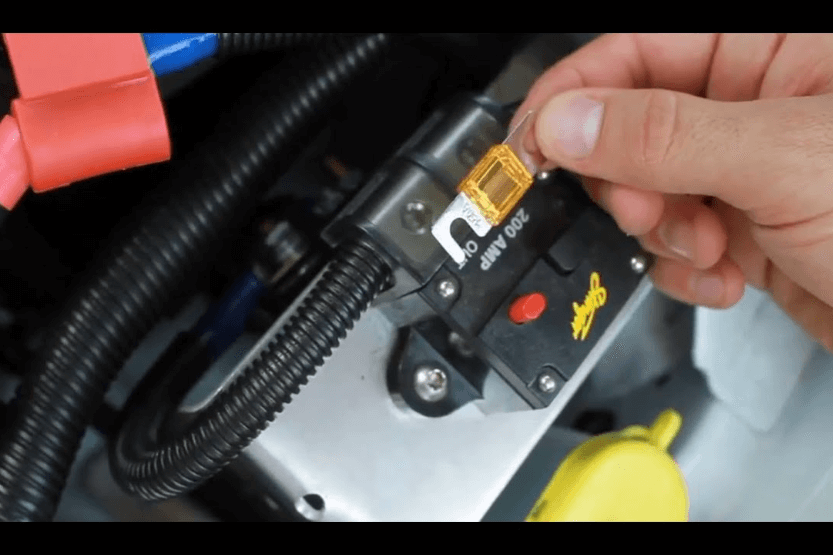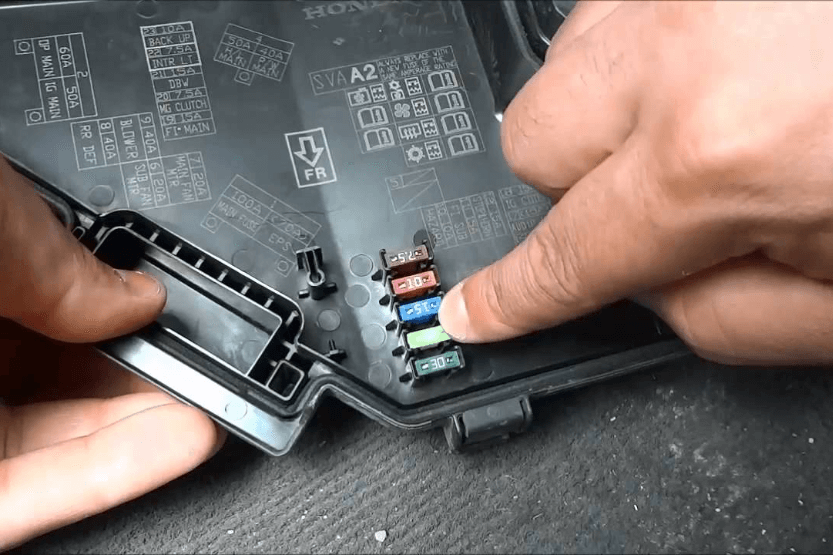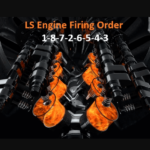ATC and ATM fuses are both types of blade fuses used to protect electrical wiring in vehicles. While they have similar functions, there are some differences between the two that are worth noting. One of the main differences is their size, with ATM fuses being smaller than ATC fuses.
ATM fuses were developed in the 1990s and are also known as mini blade fuses. They have a plastic body and two prongs that fit into the fuse holder. On the other hand, ATC fuses are larger and have a plastic body with a metal blade that runs through the middle.
They also have two prongs that fit into the fuse holder. Both types of fuses are designed to blow when the current passing through them exceeds their rating, thus protecting the wiring and other electrical components in the vehicle.
It is important to note that while there are differences between ATC and ATM fuses, they are both suitable for use in automotive applications. When replacing a blown fuse, it is important to use the correct type and rating of fuse to ensure proper protection of the electrical system.
ATC vs ATM Fuse: An Overview

Automotive fuses are designed to protect the electrical systems of vehicles from damage caused by electrical faults. Two types of automotive blade fuses are ATC and ATM fuses. While they may look similar, there are some differences between them.
ATC Fuses
ATC stands for “Automotive Type Circuit Breaker.” These fuses are larger in size than ATM fuses and are designed to handle higher amperage loads. They are commonly used in older model cars and trucks.
ATC fuses have a fuse element that is sealed inside the plastic housing, protecting it from the environment and preventing corrosion. This makes them a good choice for use on machinery that could be exposed to the weather.
ATM Fuses
ATM stands for “Automotive Type Miniature.” These fuses are smaller in size than ATC fuses and are designed to handle lower amperage loads.
They are commonly used in newer model cars and trucks. ATM fuses have a smaller footprint than ATC fuses, which makes them a good choice for use in compact spaces. They are also easier to install and replace.
ATC vs ATM Fuses
The main difference between ATC and ATM fuses is their size and amperage rating. ATC fuses are larger and can handle higher amperage loads, while ATM fuses are smaller and can handle lower amperage loads.
ATC fuses are a good choice for use in older model cars and trucks, while ATM fuses are a good choice for use in newer model cars and trucks.
In conclusion, understanding the differences between ATC and ATM fuses can help you choose the right fuse for your vehicle. It is important to choose the correct fuse type and amperage rating to ensure that your vehicle’s electrical system is protected from damage caused by electrical faults.
Are ATC and ATM fuses interchangeable?
ATC and ATM fuses are both blade-type fuses that are commonly used in automotive applications. They have similar physical dimensions and are designed to fit into the same fuse holders. However, there are some differences between the two types of fuses that should be taken into consideration.
As per Moto Pickers (.com), firstly, one of the main differences between ATC and ATM fuses is their amperage rating. ATC fuses can have an amperage rating from 0.5 to 40 amps, while ATM fuses can have an amperage rating from 2 to 30 amps.
This means that ATC fuses are available in a wider range of amperages than ATM fuses.
Secondly, while ATC and ATM fuses are generally interchangeable, it is important to ensure that the replacement fuse has the same amperage rating as the original fuse.
Using a fuse with a higher amperage rating than the original can result in damage to the circuit or even a fire, while using a fuse with a lower amperage rating can cause the fuse to blow unnecessarily.
In addition, it is worth noting that while ATC and ATM fuses are similar in many ways, they may have different breaking capacities.
For example, according to MotoPickers, every blade fuse has a breaking capacity of 32 volts. If the voltage rises above this, there is a possibility of the fuse blowing. However, it is not clear whether there are any differences in the breaking capacities of ATC and ATM fuses.
Overall, while ATC and ATM fuses are generally interchangeable, it is important to ensure that the replacement fuse has the same amperage rating as the original fuse. By doing so, you can help ensure that your vehicle’s electrical system functions properly and safely.
Types of Fuses

There are various types of automotive fuses available in the market. These fuses have different sizes, shapes, and current ratings. Some of the most common types of fuses are:
Blade Fuses
Blade fuses are also known as plug-in fuses or automotive blade fuses. They are the most common type of fuses used in modern vehicles.
Blade fuses come in different sizes, including mini, regular, and maxi. The mini fuses are commonly referred to as ATM fuses, while the regular fuses are known as ATC or ATO fuses. The maxi fuses are also called APX fuses.
Glass Tube Fuses
Glass tube fuses are the primary fuses used in older vehicles before blade-type fuses were invented. They consist of two metal end caps with a metal wire inside. These fuses are available in different current ratings and sizes.
Low-Profile Mini Blade Fuses
Low-profile mini blade fuses, also known as APS fuses, are similar to mini fuses but are shorter in height. They use the same universal Amp color coding system as mini fuses.
JCASE Fuses
JCASE fuses are a type of cartridge fuse that is commonly used in newer vehicles. They have a higher current rating than blade fuses and are designed to handle high electrical loads. JCASE fuses are available in different sizes and are color-coded according to their current rating.
Micro Fuses
Micro fuses are smaller than mini fuses and are commonly used in newer vehicles. They are available in different sizes and current ratings. Micro fuses are also available in different types, including micro2 and micro3 fuses.
Mega Fuses
Mega fuses are a type of cartridge fuse that is designed to handle high electrical loads. They are commonly used in heavy-duty vehicles and are available in different sizes and current ratings.
ANL Fuses
ANL fuses are a type of cartridge fuse that is commonly used in audio systems and power distribution systems. They have a high current rating and are available in different sizes.
AGA Fuses
AGA fuses are a type of glass fuse that is commonly used in older vehicles. They have a low current rating and are available in different sizes.
In summary, there are various types of fuses available in the market, including blade fuses, glass tube fuses, low-profile mini blade fuses, JCASE fuses, micro fuses, mega fuses, ANL fuses, and AGA fuses.
It is important to select the right type of fuse for your vehicle to ensure proper electrical protection.
Understanding Fuse Sizes
As per Next PCB (.com), fuses come in different sizes to accommodate a variety of electrical systems. The most common fuse sizes used in automobiles are mini, regular, and maxi fuses. Mini fuses, also known as ATM or APM fuses, are smaller in size than standard ATO/ATC fuses.
They measure 10.9 × 3.6 × 16.3 mm. Regular fuses, also known as ATC/ATO fuses, are the most common type of fuse. They measure 19.1 × 5.1 × 18.5 mm. Maxi fuses, also known as APX fuses, are larger in size and are used for high-current applications. They measure 29.2 × 8.5 × 34.3 mm.
In addition to these sizes, there are also low-profile mini blade fuses that measure 10.9 × 3.6 × 11.1 mm. They are designed to fit into tight spaces and are commonly used in modern vehicles.
Micro fuses, also known as APS fuses, are used in newer vehicles and measure 5 × 15 mm.
Micro2 and Micro3 fuses are even smaller and are used in newer vehicles with more complex electrical systems. Micro2 fuses measure 9.1 × 3.8 × 15.2 mm, while Micro3 fuses measure 10.9 × 3.6 × 14.3 mm.
It’s important to use the correct fuse size for your vehicle’s electrical system. Using a fuse that is too small can cause it to blow and leave you without power.
Using a fuse that is too large can cause damage to your vehicle’s electrical system and even start a fire. Always consult your vehicle’s owner manual or a professional mechanic to determine the correct fuse size for your vehicle.
Fuse Applications

ATC and ATM fuses are used in various applications, including automotive and electrical systems.
They are commonly found in vehicles, such as cars and trucks, as well as in fuse boxes and fuse blocks. These fuses are part of the blade group of fuses, which are known for their flat, rectangular shape.
ATC and ATM fuses are designed to protect electrical components and accessories from damage due to power surges or short circuits.
They are rated by amperage, which indicates the amount of current they can handle before blowing. It is important to use the correct amperage rating for each application to ensure proper protection.
Automotive fuses, such as ATC and ATM fuses, are used in various electrical systems in vehicles. They are commonly found in fuse boxes, which are located in different areas of the vehicle, such as under the hood or inside the car.
These fuses are used to protect various electrical components, such as lights, radios, and power windows, from damage due to power surges or short circuits.
In addition to automotive applications, ATC and ATM fuses are used in other electrical systems, such as in homes and businesses.
They are commonly used in fuse boxes and wiring systems to protect electrical components from damage due to power surges or short circuits. These fuses are also used in various accessories, such as power tools and electronic devices, to protect them from damage.
Overall, ATC and ATM fuses are essential components in various electrical systems.
They are designed to protect electrical components and accessories from damage due to power surges or short circuits. It is important to use the correct amperage rating for each application to ensure proper protection.
The Role of Manufacturer
When it comes to automotive fuses, the role of the manufacturer is crucial. The quality, reliability, and safety of the fuses depend on the manufacturer’s expertise and experience. Therefore, it is important to choose a reputable and reliable manufacturer when selecting fuses for your vehicle.
A good manufacturer will ensure that their fuses are made to the highest standards and are rigorously tested before being released to the market. They will also provide clear and accurate information about the specifications and recommended usage of their fuses.
In the case of ATC and ATM fuses, there are several reputable manufacturers that produce these types of fuses. Some of the well-known manufacturers include Littelfuse, Bussmann, and Eaton.
These manufacturers have a long history of producing high-quality fuses for the automotive industry and are trusted by many professionals in the field.
It is important to note that not all fuses are created equal, and some manufacturers may produce fuses that are of lower quality or that do not meet the required standards. Therefore, it is important to do your research and choose a manufacturer that has a good reputation and that you can trust.
In summary, the role of the manufacturer is crucial when it comes to selecting automotive fuses. A reputable and reliable manufacturer will ensure that their fuses are of the highest quality and meet the required standards.
When selecting fuses for your vehicle, it is important to choose a manufacturer that you can trust and that has a good reputation in the industry.
Identifying a Blown Fuse

When a fuse blows, it disrupts the electrical circuit and prevents the current from flowing. Therefore, it is essential to identify a blown fuse and replace it with a new one of the same rating.
Here are some ways to identify a blown fuse:
Visual Inspection
One of the easiest ways to identify a blown fuse is through visual inspection. A blown fuse will have a broken filament or a discolored appearance.
The fuse may also appear cloudy or have a melted appearance. However, it is not always easy to identify a blown fuse through visual inspection, especially if the fuse is located in a hard-to-reach area.
Using a Multimeter
A multimeter is a tool that can measure voltage, current, and resistance. To identify a blown fuse using a multimeter, set the multimeter to the continuity mode and touch the probes to both ends of the fuse. If the multimeter beeps, the fuse is intact. If the multimeter does not beep, the fuse is blown.
Using a Test Light
A test light is a tool that can determine whether a circuit is complete or not. To identify a blown fuse using a test light, connect the test light clip to a good ground and touch the probe to both ends of the fuse.
If the test light illuminates, the fuse is intact. If the test light does not illuminate, the fuse is blown.
It is important to note that not all fuses are the same. Different types of fuses have different ampere ratings, sizes, and shapes. Therefore, it is essential to use the correct type of fuse when replacing a blown fuse.
The ATC and ATM fuses, for example, have the same functions and use as automotive blade fuses, but the ATC is bigger than the ATM in size and ampere rating. Additionally, the ATC and ATM fuses come with LED lights on the fuse tap to make them easy to separate.
Fuse Replacement
When a fuse blows, it needs to be replaced. It is important to replace the fuse with the correct type and amperage rating to avoid damaging the circuit or causing a fire hazard.
To replace a blown fuse, first, locate the fuse box or fuse boxes in the vehicle. The fuse box is usually located under the dashboard on the driver’s side or in the engine compartment. Refer to the vehicle’s owner manual to locate the fuse box if needed.
Once the fuse box is located, use the fuse box diagram to identify the blown fuse. The diagram is usually located on the inside of the fuse box cover or in the owner’s manual. If the diagram is not available, use a fuse tester or a multimeter to identify the blown fuse.
After identifying the blown fuse, use a fuse puller or a pair of pliers to remove the blown fuse. Make sure to grip the fuse firmly and pull it straight out to avoid damaging the fuse box or the circuit.
Next, insert the new fuse into the proper slot. Make sure the new fuse has the same amperage rating as the blown fuse. Push the fuse in firmly until it clicks into place.
Finally, test the circuit to make sure the new fuse is working properly. If the circuit still does not work, there may be a problem with the wiring or the component itself. In this case, it may be necessary to consult a professional mechanic.
In some vehicles, there may be multiple fuse boxes or a fuse block. Refer to the owner’s manual or a repair manual for specific instructions on replacing fuses in these cases.
Final Thoughts
In conclusion, ATC and ATM fuses are similar in many ways, but they have some differences that can affect their performance in certain situations.
ATC fuses are larger and can handle more current, making them ideal for high-powered applications. ATM fuses, on the other hand, are smaller and more compact, making them ideal for use in tight spaces.
When choosing between ATC and ATM fuses, it is important to consider the specific needs of your application.
If you are working with high-powered equipment or vehicles, ATC fuses may be the better choice. If you are working in a tight space or need a more compact fuse, ATM fuses may be the better choice.
It is also important to note that there are other types of fuses available, including mini fuses, maxi fuses, and blade fuses. Each type of fuse has its own set of advantages and disadvantages, so it is important to do your research and choose the right fuse for your specific needs.
Overall, ATC and ATM fuses are both reliable and effective options for protecting your electrical system from damage.
By understanding the differences between these two types of fuses and choosing the right one for your needs, you can ensure that your electrical system remains safe and functional for years to come.









